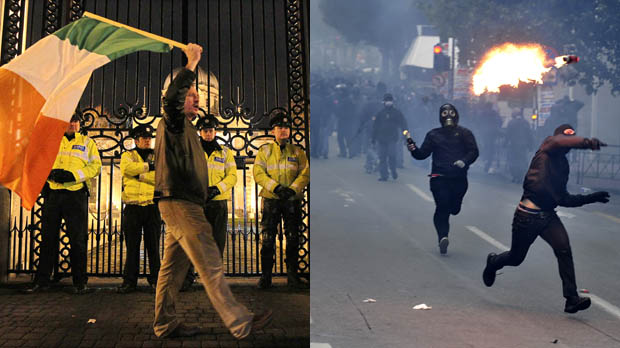‘The Irish voter doth protest too little’
Petrol bombs and burning down buildings has been the Greek public’s response to austerity measures. The Irish go for a more understated display of disgruntlement, as journalist Leo Enright explains.

As rioters began burning buildings in Athens last weekend, protesters were back on the streets in Ireland too. But instead of wielding petrol bombs and firecrackers, these demonstrators against swingeing austerity carried about as much menace as a church parade. The people of Ballyhea in County Cork are mad as hell, but they are polite about it.
The weekly Ballyhea protest is now a national institution in Ireland, and it will mark its first anniversary next month on 4 March. Often numbering fewer than two dozen people, the marchers are led by sports journalist Diarmuid O’Flynn, who says he is baffled by the apathy in Ireland. “Greece this week, Ireland next,” he declared. “This load is crushing us, [it is] a gross abuse of power by the European Central Bank (ECB) and the EU, a cynical, deliberate and calculated attack on our independence”.
But O’Flynn is not the only person baffled by the muted response of Irish people to draconian cuts. One prominent newspaper columnist recently blamed it on the low cost of alcohol, but most others suspect that something far more complex is at work.
Twelve months ago, Ireland was the first country in the eurozone to respond to the crisis by removing the country’s leadership at the ballot box. The scale of the political disaster for the ruling Fianna Fail party was unprecedented in modern Irish history: the party that was in power for 61 of the last 79 years moved from largest to third-largest party overnight.
But the honeymoon for Enda Kenny’s coalition of Fine Gael and Labour has been short-lived, as the spectacular slump in national fortunes continued: “Personal wealth has been destroyed, thousands of people are sinking into poverty, emigration has returned and unemployment is far too high”. Those are the words of the finance minister Michael Noonan as he unveiled 1bn euros in new taxes.
Noonan’s biggest tax-raising measure was to raise the VAT rate last month by 2 percentage points to an Irish-record 23 per cent. Opposition and business leaders decried the move as likely to stoke inflation and make Ireland less competitive, but Noonan insisted Ireland’s commitment to austerity was paying dividends, with this year’s deficit expected to decline to 10.1 per cent of GDP versus previous estimates of 10.6 percent – the target set by the ECB, the EU and the International Monetary Fund.
But the Irish, who have suffered five emergency budgets since 2008 following 14 years of Celtic Tiger boom, still face at least three more years of austerity to get their deficit back within the eurozone limit of 3 per cent of GDP. In addition, Irish property prices have fallen around 50 per cent from their 2007 peak and are still sliding, with hundreds of thousands of families now trapped in negative equity. Unemployment has risen to 14.4 per cent and economists predict that 40,000 of those people will emigrate.
Last year, Ireland recorded a modern European record deficit of 32 per cent because of the exceptional cost of saving five Dublin banks from the brink of default. Without that bank bailout, Ireland might never have needed an EU-IMF bailout in the first place. Most observers blame the ECB for forcing Ireland’s hand, and there is growing political pressure on the Irish government to seek a restructuring of this unsustainable debt. The people of Ballyhea demand it.
Leo Enright is the former head of radio news at the Irish broadcaster RTE.